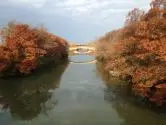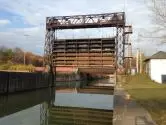From Canals to Arts and Crafts

I’m not sure if growing up on the Illinois prairie was responsible for my fascination with East Coast canals, but I never fail to get excited over the prospect of seeing one up close.
Last week, during a quick trip to Rochester, NY, I had just enough time between appointments to take a brief run out from my hotel room overlooking the Genesee River. It was unseasonably warm, which made the sight of boats already lifted out of the water and placed on shore to protect them from the inevitable return of crushing ice seem unusual.
As I jogged along, being passed by younger runners from the University of Rochester campus, I was amazed at how beautiful the park is that runs alongside the Genesee River, with its paved running and biking path meandering along the bank. Not far into my run I spotted an historical marker (something I never pass by), which alerted me to the approaching intersection of the Genesee River and the Erie Canal.
The Eric Canal. The granddaddy of all canals.
For those of you with just a foggy memory of the Canal Era in American history, let me briefly review it for you.
In the early 1800s, developers and business leaders rushed to build canals that would connect landlocked cities with each other or with larger bodies of water, such as the Great Lakes. Their fear was that the railroad barons would soon weave a spider web of steel tracks that would replace them in their role as transporters of goods to and from markets.
Their fears were justified, as soon it became evident that it is easier and faster to build narrow railroad tracks than it is to blast and dig a wide canal through bedrock. And once completed, railroads also proved to be more efficient carriers of everything from livestock and farm products to manufactured goods and people.

As a result, few canals ever showed a profit, and by the Civil War most had nearly been forgotten. But canals, even if not being utilized, don’t simply go away. In some areas they were eventually filled in and farmed, but thousands of miles of canals, along with their system of concrete and iron locks (pictured), simply evolved into man-made rivers.
In 1888, the people of Rochester decided their portions of both the Genesee River and the Eric Canal deserved to be transformed into a public park. And so they called upon the 19th century’s most prolific dean of landscape architecture.
Frederick Law Olmsted.
The designer, engineer and contractor for New York’s Central Park, as well as public parks in Brooklyn, Buffalo, San Francisco, Washington, and scores more. And who at the same time was also developing the landscape plan for George Vanderbilt’s 125,000-acre Biltmore Estate here in Asheville.
And it was Olmsted, as you may already know, who exerted the greatest influence on landscape design in the Arts and Crafts movement, as he called for the recreation of natural scenes which would provide serenity and relief from stress. And who advocated the rearrangement of the landscape for human use, convenience, safety and enjoyment – but without exploiting it.
All of which serves as yet another reminder of the widespread influence the Arts and Crafts movement has had – and continues to have – on not just architecture, but on landscape design as well.
And which we can all still enjoy and appreciate – provided we give ourselves the opportunity to go out and discover it.

Until next Monday,
“Nowadays people know the price of everything and the value of nothing.” – Oscar Wilde
Bruce
